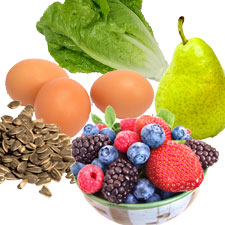Lose Weight > Common Sense To Lose Weight > Weight Loss Diet > 10 Years Thinner: 6 Simple Guidelines for 6 Weeks of Dieting
10 Years Thinner: 6 Simple Guidelines for 6 Weeks of Dieting
 For the next six weeks, you can create any meals you like as long as you follow these six simple guidelines. Thats all—theres no need to count calories or fat grams.
For the next six weeks, you can create any meals you like as long as you follow these six simple guidelines. Thats all—theres no need to count calories or fat grams.
To supply all the amino acids you need to maximize muscle tone, have one of the following: 3 to 4 ounces of skinless poultry, lean beef (sirloin, tenderloin, or roast), or seafood (fresh, frozen, or canned, the latter packed in water; limit albacore tuna to 6 ounces per week because it contains more mercury than other types); or one egg or two to three egg whites. (After youve completed the six-week plan, include a variety of vegetarian protein sources in your diet for a broader spectrum of nutrients.) Also, have one serving per meal of any kind of fresh or frozen fruits, vegetables, and/or legumes.
Yes, nuts are high in fat and calories. But theyre also great sources of protein, fiber, good fats, and antioxidants (to fight wrinkle-causing inflammation)—and, most important, theyll fill you up. Go for lower-cal nuts like almonds over higher-cal picks like Brazil nuts. If you finish your last meal more than three hours before bedtime, eat a pre-sleep snack as well. Dont like nuts or seeds? Try 2 tablespoons of organic nut butter instead.
These are the types of foods most likely to trigger food sensitivities, which may lead to bloating, low energy levels, and dry, unhealthy skin. “Food sensitivities cause a chronic state of low-grade inflammation that can hurt every system in your body, from your heart to your bones to your skin,” explains Christine Lydon, MD, who created this diet.
Its best to do without cookies, chips, etc. for the entire six-week plan, and eat them in moderation after that. Why? Processed carbs contribute to inflammation and, thus, aging, Lydon says.
Go for water, sparkling water, or iced unsweetened green or herbal tea (add fresh lemon, lime, or berry juice for more flavor) instead of diet sodas. Good news: You can treat yourself to a cup or two of black coffee or tea a day.
Take a daily high-potency multivitamin for overall good health; cold-water fish oil (2 to 3 grams twice a day) to fight inflammation, reduce sun damage, and improve skin; calcium (350 to 500 milligrams twice a day) to build strong bones; and magnesium (200 to 400 milligrams twice a day) to help your body absorb the calcium. Also, be sure your multivitamin contains 5 micrograms of vitamin D to help with calcium absorption.
Back to: 10 Years Thinner
Related Articles
-
Vacuum in The Belly – Get a Thinner Waist and Flat Stomach With This Simple Exercise
This simple technique will strengthen your abdominal muscles on th
-
The Deal With Diets